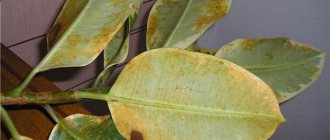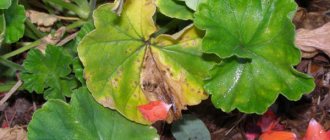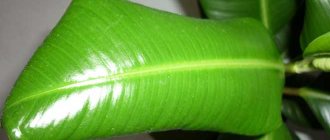Who can harm the rubber ficus, methods of pest control
Most often, the plant is attacked by scale insects, spider mites and mealybugs. Stores for flora lovers have the necessary preparations for pest control. Their instructions describe in detail the dosages and sequence of actions.
The main parasite is the scale insect. The scale insect on the ficus sucks the plant juice from the leaves, the leaves become covered with a sticky substance and emit an unpleasant smell of rot.
If you do not fight the pest, the ficus will die.
To remove scale insects from a plant, wash it with warm water and laundry soap. Carefully go over all the leaves and branches, but avoid getting them on the soil so as not to damage the roots of the ficus.
After the shower, let the flower dry in a warm place, then you need to sprinkle the leaves and soil of the plant with tobacco dust. Tobacco kills the scale insect and will not start again, especially after preventative washing with soapy water.
Small white dots along the edges of the leaves of Ficus benjamina and Rubber-bearing ficus
There are two options for the reasons for the appearance of white dots along the edges of ficus leaves, and as a result, two courses of action in the event of the appearance of specks.
To understand which option is yours, carefully examine the greenery of the plant, paying attention to both the upper and lower sides of the leaves. Also take a look at the stem, examine in detail the edges of the ficus leaves where the white dots appear. Next, draw conclusions about the reasons and determine your further actions.
White dots along the edges of the leaves of Ficus benjamina and Rubber-bearing ficus
1. Carefully inspect the small white dots around the perimeter of the ficus leaves: if they are not convex to the touch, they are present only on the upper side of the leaf, and the lower part and stem are clean, if the dots are not washed off with water, are not erased, and you get a feeling as if someone simply poked all the leaves with a needle, they themselves look healthy and do not fall off, then there is no need to worry.
What to do if leaves fall from ficus
Many plant lovers believe that the falling of the lower leaves of ficus is the norm. This is not entirely true. The tree ages, and the lower leaves fall off for natural reasons, but the trunk should not be bare. Exposure of the trunk is no longer good; soil composition, temperature and light conditions can affect this.
The causes of diseases of rubber ficus are mainly related to its care. Firstly, the plant's root system may be damaged. Most likely, the wrong watering regime is to blame. Here you need to reduce watering and arrange a greenhouse regime for the plant.
If the plant was damaged as a result of improper transplantation , water the ficus with a cycron solution - add four drops per liter of water.
Keep the soil moist.
The most unpleasant reason for shedding leaves is rotting roots. Signs: falling leaves, soft trunk with substance oozing from it. There is no treatment , the plant must be thrown away and the place where it is kept is disinfected.
If at first you observed the growth of new leaves, and then the leaves began to turn black and fall,
The reason is
excessive watering. Due to excess moisture, the ficus roots begin to rot. Solution: water only when the top layer of soil dries, cover the tree with film, maintain high temperature conditions and spray under the film.
Symptoms of leaf disease
Most often, ficus health problems arise due to violation of the conditions of its maintenance. Before you start treating a plant, you should carefully familiarize yourself with the existing signs, on the basis of which you can establish the cause of the disease and take measures that best suit the specifics of the situation.
Turn yellow and fall off
Ficus lovers encounter this problem most often. It is important to consider that the described plant regularly sheds its yellowed lower leaves (the oldest ones), this is not a deviation from the norm. You should be concerned in situations where these symptoms affect all plates of the rubber-bearing ficus - even those located on the upper shoots. If we highlight the causes of the misfortune in question, then their list will look like this.
- Too frequent and/or abundant watering, leading to rotting of the plant’s root system. A characteristic sign is an unpleasant odor emanating from the soil.
- Moisture deficiency. If this problem occurs, the ficus leaves may change color from dark green to yellow and fall off over time.
- Excess minerals. Situations where the soil has accumulated excessive amounts of salts can lead to the loss of all foliage and death of the plant.
- Insufficient lighting. Despite the high shade tolerance of the rubber ficus, its location in twilight significantly weakens its health.
- Deficiency of nutritional components. It appears in situations where the plant remains in the same soil for a long time and is not fertilized properly.
The loss of healthy, unaffected leaves by the rubber-bearing ficus deserves special mention.
The most common cause of this problem is overcooling of the plant’s root system, which is especially dangerous in combination with strong drafts.
Curl up
Considering that the leaves of the rubber-bearing ficus take part in the respiration of the plant and the processes of water evaporation, it should not be surprising that they curl due to its deficiency. This is a natural reaction of the plant in situations where the temperature is too high and the humidity level is unacceptably low. In a similar way, ficus reduces the intensity of evaporation, which threatens it with dehydration, which is important for rooms with dry air (especially if they are equipped with air conditioning and heating devices).
Another reason that can lead to the problem in question is insufficient and/or irregular watering. To determine the degree of soil moisture, you need to stick a wooden stick into it to the depth of the roots, and then carefully pull it out. Pieces of soil adhering to it will indicate that there are no problems with moistening the substrate, while a dry surface of the tool used will be a sign that the plant needs more water.
If there are small white dots on the curling leaves of the ficus, we can ascertain the presence of a spider mite - a dangerous parasite that feeds on the juices of the plant and leads to its depletion. This pest prefers to be located on the inner surface of the plate, but traces of its activity are also noticeable on the outer side, which gradually becomes discolored.
Why do the leaves turn yellow?
There are several reasons why rubber plant leaves turn yellow. If you notice this in your plant, change the frequency of watering. Ficus reacts actively to both large and small amounts of moisture.
If you suspect that the tree is not getting enough light, move it to a brightly lit area, but not in direct sunlight.
The plant may get burned.
A possible cause of the disease may be the size of the pot. The ficus will become cramped over time. Try to transplant it into more comfortable conditions.
Fungal diseases also cause yellowing of leaves. Cercospora is a fungus that spreads black spots on the leaves, then the leaf turns yellow and falls off.
A fungicide solution will help get rid of the fungus .
Treat the plant with it and inspect neighboring flowerpots - the fungus may spread. Botrytis is a fungal parasite that affects leaves with yellow-rusty spots. The spots grow quickly, causing the death of the plant.
Inspect the diseased tree, remove branches and leaves damaged by the fungus. Then treat the ficus with a fungicide.
To avoid the return of the disease, carry out preventive spraying with the medicine.
Fungal and infectious diseases
Ficus Benjamin diseases are not as easy to eliminate as pests. The reason is that signs of some changes do not appear immediately, but gradually. Sometimes gardeners cannot recognize them even at an advanced stage.
If we talk about which diseases of rubber ficus are the most common, then the following should be noted:
- sooty mushroom;
- mold;
- root rot;
- fungal diseases of leaves.
Sooty mushroom
This disease is caused by scale insects and aphids. If pests are identified in a timely manner, Ficus Benjamin will not be affected by diseases. The disease is eliminated by treating the flower with a soap solution or fungicides.
Mold
Another disease is called gray rot, during which the leaves darken and then die. With such a disease of ficuses, their treatment is carried out comprehensively. The affected areas are removed, the amount of watering of the flower is reduced, and the room is well ventilated.
Root rot
Unfortunately, this problem can rarely be solved, since the flooded flower, or rather its root system, completely rots.
Brown spots on rubber ficus
If you notice that brown leaves have appeared, do not rush to panic. Many types of ficus grow leaves of this color - this is a physiological property, not a disease. This happens due to possible stress during landing. Just improve your tree care.
Brown spots on the leaves indicate excessively high temperatures, as well as excessive feeding.
Reddish-brown spots indicate burns. Perhaps the flowerpot is located in direct sunlight. Place it in a less lit place, but not dark.
Another reason for the appearance of stains is draft and overflow. Move the plant to a quiet place without access to cold air and moderate the frequency of watering.
Anthracnose is another explanation for the question of why brown spots appear on ficus leaves. This is a fungus that causes burns on the leaves, which leads to further falling off.
Treatment is to remove all diseased surfaces and treat with a fungicide.
Ficus benjamina has white dots on the leaves.
Diseases and pests in ficus, brown spots appear on the leaves, or they turn black or curl, fungal diseases in the plant. Most often, people experience difficulties in caring for ficus benjamina, although the description below can also be applied to f. rubbery, lyre-shaped or microcarp.
Be careful when buying a plant, lift the leaves up. Look for signs of pests or disease. If you find any, keep the plant and don't buy it. Avoid buying a flower with damaged or damaged leaves.
With proper care, ficus trees usually do not get sick, but pests or infection can easily be brought into the house with a new plant, cuttings, changing the soil, or when taking it out into the open air. Sometimes it happens that the ficus turns black and crumbles accordingly.
The most common ficus diseases are caused by pests such as spider mites, aphids, and scale insects. You can see the common spider mite on the underside of leaves and on the tips of shoots. The upper side is often covered with dots and yellow spots, and cobwebs can be seen between the leaves. Frequent spraying with water and washing the leaves will help to cope with the pest.
The appearance of false scale insects and scale insects is accompanied by growth retardation, the formation of brown spots, and a sticky coating on the leaves and trunk of the ficus. The leaves turn yellow and the ficus falls off prematurely. The pest attaches itself to the plant and if it is not treated in time, the plant will die. Proper care and constant inspection of the ficus will help detect diseases or pests at an early stage, when the plant can be saved.
The appearance of brown or red spots on ficus leaves indicates a fungal infection. Gradually, the spots grow and the leaves die. Poor placement of the pot and improper care contribute to the appearance of this disease. Dampness poses a particular danger. A sick ficus should not be sprayed, and all infected leaves must be removed.
One of the diseases characteristic of some plant species is gray rot. This fungus is quite easy to detect - gray mold forms on the leaves and stems, the affected parts quickly darken and gradually die. Removing the affected parts, reducing watering, ventilating the room and treating the plant with insecticides will help get rid of the scourge.
Rotting of roots and stems manifests itself in wilting, despite soil moisture. The leaves turn gray, and pockets of rot can be found at the base of the stem. It is almost impossible to save the affected plant.
Powdery mildew is a white, easily erasable coating that often appears with poor ventilation. The presence of sunburn or areas damaged by pests makes it easier for fungal spores to penetrate. Black sooty fungi appear on the secretions of pests: aphids, scale insects, mealybugs, whiteflies. Aphids attack young shoots of ficus trees with tender leaves.
Lack of lighting, especially in winter, low temperature and its sharp fluctuations, drafts, excessive watering and stagnation of water lead to the gradual death of the plant. The top layer of the substrate does not dry out for a long time, the tops of the shoots droop and die, there is a different smell of rot from the soil, the leaves darken and fall off.
With insufficient watering, the leaves of the ficus dry out, curl and fly off, the branches become dry and brittle, and the soil lags behind the pot. Try to avoid excessive doses of fertilizers, pesticides, and dosage violations. Root burn most often occurs when fertilizer is applied to dry soil, without first wetting the substrate with water. You should be alert for the appearance of deformations, damage, various spots, and pests on the leaves.
Causes of the disease
It is better to identify it at an early stage in order to take timely action, so the flower must be periodically inspected and dried leaves removed. In severe cases, complete replacement of the soil, trimming of rotten roots, dusting the cuts with charcoal powder, and replanting into a smaller pot will help. In especially severe cases, rooting cuttings cut from the plant.
To combat pests and diseases, folk remedies and specialized preparations are used. Any insecticide is effective when treating ficus trees. The best remedy for the spread of fungal diseases is treating the crown and root system with a fungicide solution.
Carefully remove leaves with spots from ficus plants, and then treat the plant with a copper-soap solution: 20 g of soap (preferably liquid potassium soap) is dissolved in 1 liter of warm water. In a separate bowl, dissolve 2 g of copper sulfate, which is added to the soap solution and, after mixing, the plant is sprayed (it is important that the solution gets on the underside of the leaves. Copper oxychloride and cuprosan are also used to combat fungal infections.
Why did the rubber ficus drop its leaves?
Your tree was bright, with succulent leaves and a beautiful crown, but for some reason it began to fade. The cobwebs on them will tell you why your ficus leaves have drooped. a spider mite on the ficus . This pest drinks juice and nutrients from the leaves. You can get rid of it with tobacco infusion. Wash away the plaque that appears on the ficus leaves with this liquid. Cover the tree with film or a plastic bag for two days.
Remember, ticks breed in extreme heat and dry air.
Why does the leaf become stained?
Spots on ficus leaves arise due to the gardener’s unscrupulous care for the plant, as well as due to the activity of the fungus and parasites that attack it.
The photo shows spots on ficus leaves
Let's look at the reasons for the appearance of uncharacteristic patterns and colors of foliage, which are most common:
| Color | The root of the problem |
| Brown leaf color | Characteristic of some types of ficus. The plant may have suffered stress after transplantation. |
| Brown spots | Increased temperature and dry air. Overfeeding with mineral fertilizers. |
| Reddish-brown spots | Sunburn. Exposure to draft. Excessive watering. Infestation by fungus or parasites. |
| Brown plaques along leaf veins | Scale insect infestation. |
| Brown spots resembling strokes in shape | Thrips infestation. |
| Small yellow dots, yellowish leaf edges | Overflow. |
| Red dots, whitish coating | Leaf damage by thrips larvae. |
| White or grayish spots, cobwebs | Spider mite infestation. |
Ficus foliage burns photo
All about diseases of rubber ficus leaves
Among all the tropical plants that effectively decorate homes, offices and apartments, the rubber-bearing ficus occupies a special place - a species that has many obvious advantages. One of them is the unpretentiousness of the ficus, thanks to which it can successfully develop in a variety of conditions, often far from ideal. Despite this advantage, in some cases the leaves may suffer from diseases that pose a serious threat to the health of the plant and therefore require the utmost care.
Why do leaves turn yellow and fall off?
Many tree-like species of ficus shed their leaves for natural reasons, for example, in the autumn-winter season. If the leaves began to fall at an accelerated pace, then the problem should be looked for in insufficient watering. Changing the place where it grows also has a bad effect on the health of the ficus. In addition to the above, the deterioration of the plant’s condition, yellowing and falling of its leaves may be affected by:
- Excessive watering.
- Lack of light.
- Heat and dry air.
- Low temperature and hypothermia of the plant.
- Excessive sun exposure.
- Overdrying of the soil.
- Underfilled.
- Lack of minerals in the soil or their excess due to overfeeding.
- Infestation by pests, fungus or infection.
- The wrong size pot.
ficus yellowing leaves photo
Infections and fungal infections
Proper care will keep any plant healthy. But sometimes even he is not able to get rid of unwanted problems that arise due to the diligent care of the gardener. Ficus diseases also occur due to external factors: initially hidden diseases in newly purchased plants, cuttings, when replacing the soil mixture or transplanting into open ground.
Infections and fungal infections of ficus
Attention! Even prepared soil purchased in a store does not always guarantee that conscientious manufacturers have disinfected it from ficus pest larvae.
The most common diseases of any type of ficus genus include:
Powdery mildew
White spots that look like a fluffy coating that are easily erased.
Reason: from direct sunlight, places damaged by insects, subsequently infected with fungus. Treatment: The plaque is washed off with a sponge soaked in soapy water. Severely affected leaves are removed. The plant is treated with a fungicide.
Anthracnose or rust
Uneven, rusty spots with a brown border along the edge of the leaf. After some time, holes form in their place. Later the leaves completely darken and die. Cause: Fungus Colletotrichum orbiculare. Treatment: Diseased areas are cut off, the ficus is treated with fungicide and copper oxychloride.
Cercospora
Small brown or black dots at the bottom of the leaf, which gradually increase in size. After a couple of days, the leaf withers and dies. Reason: Dampness, waterlogging in the room. Infection with a fungus of the genus Cercospora. Treatment: spraying with a fungicidal preparation.
Botrytis, gray mold or mold
Foliage with a gray coating. If you shake it, dust consisting of tiny fungal spores rises into the air. As the disease progresses, brown spots with a dark halo appear. Soon the leaf darkens and falls off the stem. Cause: Increased temperature and humidity. Infection with the mold Botryotinia fuckeliana. Treatment: Treatment with insecticides, fungicides and removal of infected parts.
Root rot
Wilting, gray foliage. Rotting of the base of the stem and root system. Reason: Strong overflow. Root damage by fungal spores. Treatment: Doesn't exist. It is recommended to discard the plant.
Sooty mushroom
The leaves become covered with a gray or blackish coating, similar to soot, and emit a rotten smell. Cause: Sticky secretions of insects with simultaneous infection by a fungus that feeds on these waste products. Treatment: Wash the plants with soapy water. Removing infected leaves and treating with a fungicidal solution.
What can a ficus suffer from? How to identify a disease by the leaves of a plant and cure it?
Powdery mildew is considered one of the most common diseases of ficus. This disease is easily recognized by white spots on the leaves of the flower, which can be wiped off with your hand.
Powdery mildew on ficus
The cause of this disease can be an excess of direct sunlight, too high a room temperature, excess humidity, as well as damage to leaves by insects. Treatment is best done at the initial stage, using a soap solution and a sponge. If the leaves are already too heavily stained, they must be removed and the plant sprayed with a fungicide.
Another most common disease of ficus and other indoor plants is anthracnose or rust. This disease is accompanied by the appearance of yellow to dark brown spots. Later, the leaves become covered with ulcers, and the ficus begins to shed them, as a result of which it can become completely bare. You can cure flowers affected by rust using a fungicide.
Insect pests
Most often they attack a weak plant. The rapid growth of numbers in colonies is provoked by the close proximity of flower pots and poor care of ficuses. By themselves, they do not lead to the death of the plant, but if infection with a fungus joins their negative activity, the flower can quickly die. To know the enemy by sight, you should familiarize yourself with the most common insects that are most likely to visit the plant, and more than once.
Spider mite
Prefers to be located on the underside of leaves and tips of shoots. Its bites lead to the appearance of gray-brown spots and dots on the outside of the foliage. Traces of cobwebs can be found on the ficus. Treatment: Washing with soapy water and further treatment with Bordeaux mixture. You can spray the flowers with ground sulfur and garlic tincture, covering the ficus with polyethylene for 3-4 days. It also works well in pest control and is an insecticidal drug.
How to care for rubber ficus at home
Also check out these articles
- How to plant gooseberries with seedlings in spring
- Apple tree variety Semerenko
- How often and how to water flowers correctly
- Description and characteristics of Daikon radish
In order for the ficus to develop normally, it needs to be provided with saturated but diffused light or partial shade. Rubber-bearing ficus grows at a temperature of +20...+25 degrees in the warm season and at a temperature of at least +15 degrees in winter. But in addition to a normal place, light and temperature, it is important to provide proper care at home.
At low humidity it is necessary to spray additionally
- Watering in summer is carried out once every 3-4 days, and in winter no more than once every 7 days. But here it is important to pay attention to the condition of the soil. In winter, watering is carried out only when the soil in the pot dries out.
- The humidity should be high; if it is low, then it is necessary to additionally spray it or wipe the leaves with a damp cloth.
- Pruning is carried out to regulate the height of the ficus. In the case of the rubber ficus, there is no point in cropping the top in order to provoke the growth of the lateral pagons. It is better to remove 5-6 internodes. To get a beautiful bush, it is best to plant 3-5 plants in one large pot, then it will seem that the plant is branching, although this is not the case. Pruning is always done in the spring. Trimming is carried out only with a sterile blade, and the juice that appears during cutting must be washed off with water.
Ficus rubber plant propagates by cuttings or layering
Important!
The sap of the ficus rubber plant is poisonous, so it is important to ensure that pets such as cats and dogs do not play with the leaves or try to eat them. If it comes into contact with the skin, it can cause irritation or allergies, so it is important to wear gloves when transplanting. But for the ficus itself, its juice is healing, it heals broken bones and wounds.
- It is difficult to form at home because it grows with one trunk, without branches on the sides. To make a beautiful composition, it is necessary, as mentioned above, to plant several plants in a pot. When they grow up, they are trimmed as desired.
- Feeding is carried out from mid-spring to September - during the period of active development. Minerals with an abundance of nitrogen are used as fertilizers. From October to March the plant has a dormant period, so fertilizing is excluded.
- Once every 2-3 years, an adult rubber ficus is transplanted into a larger pot or simply replaced with a new top layer of soil. Young crops must be replanted every year. To do this, take a new pot, slightly larger in size, so that the roots can develop.
Prevention of ficus diseases
The new seedling is isolated for at least 7 days in a separate room. If after quarantine no signs of disease are found, then it is placed with the rest of the plants. To prevent the development of diseases, it is recommended to examine the ficus daily for uncharacteristic external changes. It is not advisable to place pots close to each other. After transferring or replanting flowers from the garden to the house, their leaves should be wiped with a solution of laundry soap.
Attention! Do not buy ficus trees with damaged or limp leaves. A sick plant will not be able to adapt to a new location and will quickly die.
Experienced flower growers advise regularly cleaning trays and pots, not overwatering or overfeeding the plant, monitoring the level of humidity and air temperature in the room, and also not placing flowers under the scorching sun. Disinfection of soil prepared independently or purchased in a store is carried out using a weak solution of potassium permanganate. Treating the ficus with a fungicide solution, copper oxychloride and cuprosan will get rid of the fungus. Any insecticide will work against insects.
To increase the resistance of ficus to external harmful factors, use Epin and Zircon. In severe cases, it is necessary to replace the soil and replant it in a new pot with pruning of the affected areas of the stem and rhizome. The sections are dusted with charcoal powder. From March to September, once every two weeks the soil can be fertilized with magnesium sulfate, Potassium Mag, iron chelate, Ferovit, dolomite, or fed with Emerald leaf fertilizer.
Ficus deltofolia
Ficus deltolea, or in Latin Ficus deltoidea, is another interesting type of ficus with leaves like the triangular ficus, but with smoothed edges and a more rounded shape. Throughout the year, small inedible yellowish fruits ripen on the tree.
It grows very slowly and can only reach 80 cm in height in its entire life.
And this is not the entire list of ficuses popular in floriculture. Breeders do not sleep and create more and more new varieties. There is plenty to choose from for both beginners and experienced gardeners.
And be sure that the ficus you love will delight you with its presence for many years - after all, almost all ficuses are long-lived.
Video on the topic: Diseases and pests of ficus
The presented video talks about how to save ficus from various diseases.
Ficus is one of the few low-maintenance representatives of the indoor plant world.
Beginning flower growers can easily handle it.
But if you make mistakes in care and do not provide timely prevention, various types of diseases and infections can befall him.
In this case, the plant will get sick and may even die.
To avoid negative processes, proper content is necessary.
Ficus diseases
Ficus is one of the most popular indoor plants; this flower looks great both at home and in the office, and it does not require special care. However, even such an unpretentious plant as ficus is affected by various diseases and pests, due to which the flower can wither and even die. To prevent diseases of ficus leaves, first of all, the plant needs to create comfortable living conditions. The flower must receive a sufficient amount of sunny color and be at a temperature that is comfortable for it. Watering should not be scanty, but you should not overwater the ficus either; the same goes for fertilizers: their amount should not be lower or higher than normal. If you grow a ficus in the right conditions and provide it with proper care, then the likelihood of the plant being damaged by infections, fungi and pests is significantly reduced. But even proper care and comfortable conditions cannot guarantee complete protection of a flower from diseases.
Initially hidden diseases may appear in recently purchased ficus plants; the plant can also become infected when transplanted into another soil. However, almost all ficus diseases are curable, the main thing is to detect them in time.
Care problems
To avoid any difficulties in the future, it is necessary to carry out a careful inspection at the time of purchase.
The leaves should be elastic, rich green in color without visible damage or defects, and the whole plant as a whole should have a healthy appearance.
If there are spots on the foliage, small rashes, or any other visible imperfections, most likely this flower is sick and can infect other indoor plants.
At first, keep the newly purchased flower separately from other plants. This is necessary in order to identify possible problems. After a month or two, if no pests or diseases have appeared, it can be placed near other flowers.
Diseases can occur in the event of the following care errors:
- temperature imbalance;
- excess or deficiency of air humidity;
- untimely or frequent watering;
- lack or oversaturation of essential microelements.
The leaves are turning yellow, what should I do?
The leaves may take on a characteristic yellow tint in several cases. The first reason is most often that the air in the room is too dry. This problem often manifests itself in the summer with the onset of heat and during the heating season, when using heating devices. In this case, the foliage gradually fades and falls off.
Another reason for yellowing leaves is burns caused by direct sunlight.
How to save a plant from this?
- In summer, the flower should not be exposed to direct sunlight for a long time.
- In winter, it is better to relocate it to places far from the batteries.
To humidify the air, use a container of water near the plant.
Spots on leaves
If freckles appear on the leaves in the form of yellow or brown spots or the edges begin to take on a sandy tint, this is most likely a consequence of waterlogging in the soil. These symptoms indicate an excess of moisture in the soil and possible rotting of the root system.
It is urgent to dry the soil and review the watering rules. Ficus does not tolerate stagnation of water in the pan. Drafts and, in general, any sudden change of environment are harmful to him.
What other reasons can negatively affect ficus?
If the leaves turn black or their color changes to dark brown, it means that the room is either too hot, or the grower has gone too far with the frequency of fertilization.
You should not immediately blame diseases and pests if the plant sheds its lower leaves. This is an absolutely normal process. There is no need to do anything.
However, if the process does not stop and the trunk is noticeably exposed, then it is urgent to transplant the flower into new purchased soil. Most likely, the substrate was chosen or formulated incorrectly.
The dying off of the foliage indicates that the ficus has been affected by disease. We can say more accurately after a thorough examination of the plant.
Fungal diseases
Gray rot
Such a disease can be detected simply by examining it. A characteristic sign is mold throughout the plant . It is capable of dusting not only the leaves, but also the branch and trunk, acts like ordinary dust, and is easily shaken off at the slightest contact.
Infected areas become dark and die over time. A favorable environment for the development of gray rot is dampness and warmth.
Sooty mushroom
A gray or black coating forms only on the foliage.
Appears in the presence of aphids, scale insects and similar pests when they secrete sticky mucus.
In this case, you need to eliminate the contaminated area or treat it with a solution of soapy water using a sponge.
Then spray the entire flower, right down to the roots, with the funkicide solution.
Powdery mildew
It has all the same symptoms as sooty fungus, but is distinguished by a white coating on the foliage , which is easily washed off in the initial stages of the disease with a solution of laundry soap. If the stage is more serious, the affected areas are removed.
Cercospora
Dark spots that spread along the underside of leaves. The disease originates and develops in the Cercospora fungus in waterlogged air. The spots gradually grow throughout the plant, after which the leaves dry out and fall off; in some cases, the ficus may not be saved.
This problem can be solved by spraying with antifungal drugs , after removing the diseased leaves.
Anthracnose
Infection with anthracnose has almost the same symptoms as cercospora. Only in addition, wounds also form on the edges of the leaves.
You can also get rid of this disease with antifungal drugs.
Root rot
The usual process of rotting of the root system is caused by an excess of soil moisture. In this case, the ficus has little chance of life.
To prevent this disease, water with a weak solution of potassium permanganate no more than once a month.
Determining the type of disease
It is necessary to correctly identify a tree disease. This will allow you to correctly apply the remedy to save it:
- Infections are the result of exposure to bacteria. They may not be noticed immediately. The first sign of the disease is the appearance of dark spots, traces of rust, or yellowing of the leaves on the ficus leaves. For control, it is best to use fungicides. They must be applied taking into account the level of damage to the plant. In most cases, 2-3 waterings over 10 days will be sufficient.
- Fungal infection - can be detected by a characteristic odor and the appearance of rot on the stem or leaves. It is also possible for plaque to form in various colors. It is necessary to fight by removing the affected area. To prevent relapse, you should use fungicides.
Insect pests
A very dangerous pest not only for ficus, but also for any other plant. She attacks, sparing nothing in her path. A sticky web envelops the leaves, which as a result curl and die.
Infection spreads instantly , since aphids are flying pests. When fighting it, special preparations are used that are diluted with water and the diseased plant is sprayed with this solution.
Shchitovka
If dark convex spots appear on the inside of a ficus leaf, reminiscent of “internal pimples”, if the leaves curl inward, then it’s a scale insect! This pest feeds on the sap of the flower, leaving behind a sticky mucus in which a sooty fungus develops.
If a scale insect is detected, you need to treat the entire plant with a soap solution, and then with special preparations - insecticides.
Spider mite
A favorable environment for life and development is warm and dry air. After visiting this tick, brown spots remain. The areas of the plant he visited die off. When a flock of mites is working, a special web appears on the flower. It reproduces very intensively.
This problem can be solved by wiping the leaves with a soap solution or treating them with chemicals. After processing, the ficus is wrapped in polyethylene.
Here's how experienced gardeners deal with spider mites:
Thrips
Very small, black midges live on the inside of the leaf. They feed on ficus juice. Brown spots appear. They actively reproduce in warm and very humid rooms. The leaves acquire a yellow-white color, gradually dry out and crumble.
Treatment: the infected plant must be treated several times with a pyrethrum-based solution.
Nematodes
This pest attacks the root system. Growths appear on the roots in the form of balls and nodules. They release toxic substances that penetrate the trunk into the leaves and spread the infection. The flower begins to turn pale, dry out and eventually die.
To revive the ficus, it must be removed from the pot and immersed with its roots in an insecticide solution for several hours. After this procedure, the flower is planted in new soil.
LiveInternetLiveInternet
Ficus is considered an unpretentious plant, however, if the basic rules and requirements for living conditions and care are not followed, it can become seriously ill and even die. As with other indoor plants, problems with ficus can arise due to improper care, fungi and bacteria, as well as insect pests.
How to properly care for a ficus so that it does not suffer from diseases? Let's start by purchasing a plant at a flower shop - here the flower is examined to identify signs of possible diseases and pests. Ficus leaves should be dense, dark green; if there are yellow, white or brown spots and dots on the leaves, it means the plant is sick and you should not buy it, so as not to infect other house plants.
The ficus brought home is kept separately from other plants for a week. If diseases and pests do not manifest themselves during this time, it can be placed next to other flowers. You should not place pots of flowers too close to each other - in close quarters, diseases and pests multiply and are transmitted faster.
Ficus often turns yellow due to temperature changes
At least once a week, ficus and other indoor plants should be inspected in order to notice diseases and pests in time and take appropriate measures. Once a month, ficus leaves are wiped with soapy water; it is better to use laundry soap that does not contain chemical additives that can harm the plant.
Non-infectious ficus diseases occur in unfavorable conditions - improper lighting, poor temperature conditions, excessively humid or too dry air, poor-quality watering, deficiency, or vice versa, excess of minerals in the soil.
Ficus leaves turn yellow if the air in the room is too dry. This phenomenon is observed both in hot summer and during the heating season. The leaves wither and dry out due to constant exposure to heating devices that emit heat. If the leaves fall too much, the plant cannot be cured and it dies.
Therefore, in summer the ficus is not kept on the windowsill in direct sunlight, and in winter it is removed further from radiators and other heating devices. Spots on the leaves can also appear due to sunburn.
The air for the ficus can be humidified using a special humidifier or any container of water placed next to it.
If the soil does not have enough nutrients, new ficus leaves become smaller, and old ones turn yellow and fall off. To prevent the development of disease and death of the flower, it is transplanted into fresh, mineral-rich soil, or fed with fertilizers. The substrate for replanting is prepared from sand, leaf soil and peat. If the flower is too
It is large and difficult to replant; you can replace the top part of the soil and water it properly.
Excess fertilizer can also cause brown spots to appear on the leaves, so fertilizers are used in strict accordance with the instructions on the package.
If yellow spots appear on the leaves, or the leaves turn yellow at the edges, there is most likely too much moisture in the soil. Watering should be stopped and the soil should be allowed to dry. The worst thing is if excessive watering causes root rot, in which case it is very difficult to cure the plant. If the rot has not completely affected the roots, the diseased fragments are removed, and the healthy ones are planted in another soil, having first disinfected the pot.
Problems with ficus can also arise due to insufficient watering, or watering with low-quality tap water. The leaves will begin to dry, turn yellow, and crumble. If drought has had its detrimental effect on the leaves, then the roots are also in poor condition. Ficus in dry soil is placed in a deep container with water for 2-3 hours so that the soil is completely soaked. During this procedure, part of the soil may end up in the container, so soil is added to the pot after the procedure.
Tree ficus leaves drop due to age, this is not a disease and no treatment is required. Its lower leaves fall off, but new ones grow at the top of the trunk, so the trunk is never exposed. However, if new leaves grow very poorly, or do not grow at all, you need to think about transplanting the ficus into new soil, or about feeding.
There are several viral and fungal diseases that damage the leaves and roots of ficus trees. Let's call them:
Gray rot - with this disease, mold appears on the leaves and stems, which flies into the air after shaking the leaf. Damaged leaves become covered with brown spots, then darken completely and fall off. Gray rot fungus develops well in warm and humid air, so the room should be ventilated as often as possible.
To cure a ficus, damaged fragments must be removed at the very beginning of the disease, otherwise it will not be possible to save it. Healthy parts are sprayed with fungicides. Watering is reduced at this time.
Sooty fungus - a good environment for the development of this fungus is the sticky secretions of aphids, scale insects and other insect pests. The sooty fungus leaves behind a black coating on the leaves.
Powdery mildew - with this disease, a white coating in the form of flour appears on the leaves. In the initial stages of the disease, the white coating is easily washed off, so the leaves can be wiped with soapy water. If the plant's condition is neglected, it is very difficult to cure it - the affected leaves are removed, and healthy leaves are sprayed with fungicides several times.
Cercospora is a fungal disease that develops from Cercospora fungi at high air humidity. With this disease, small brown or black dots appear on the underside of the leaf blade, which gradually grow. As a result, the leaves begin to turn yellow and fall off. If the disease is not stopped, the entire plant may die.
Treatment of the disease consists of removing damaged leaves and spraying with antifungal drugs.
Anthracnose is a disease in which rusty spots appear on the edges of leaves, which turn into sores. Leaves affected by anthracnose die, as a result, the ficus may die entirely. The treatment is similar - treatment with fungicides.
Root rot is a disease caused by waterlogged soil. Damaged roots are unable to provide the ficus with adequate nutrition and moisture, as a result it dies. In this case, it is impossible to save the plant; it is thrown away along with the pot.
To prevent rotting of the roots, you need to water the ficus moderately, as the soil dries, using clean water. As a preventative measure, you can water the ficus once a month with a weak pink solution of potassium permanganate, and add a little charcoal to the soil mixture when planting and replanting.
Ficus pests also cause spots and dots to appear on the leaves, but they can destroy the plant only if they multiply and spread too much. The danger of insect pests is enhanced by the fact that their sticky secretions are a breeding ground for fungi, which lead to the death of the ficus.
Ficus pests are quite numerous - these are aphids, scale insects, spider mites, thrips, nematodes, and scale insects.
Scale insect - the first sign of the appearance of this insect on a ficus is brown convex spots on the underside of the leaves, sometimes spots appear on the stem. The scale insect feeds on the sap of the plant and leaves a sticky coating in which a sooty fungus develops.
In order to cure a ficus from scale insects, the leaves on both sides are washed with a soap solution and then treated with Actellik. Treatment is carried out for three weeks in a row, once a week.
The mealybug also sucks the juice from the leaves, causing them to become deformed and stop growing. The worm settles in the axils of the leaves, so when treating these places you need to pay special attention.
Mealybugs are gotten rid of by mechanically cleaning the leaves and treating them with soapy water and tobacco solution once a week. When neglected, the ficus is sprayed with confidor twice every 10 days.
Spider mites develop well in dry and warm rooms. After the mite, gray or brown spots remain on the leaves. The insect reproduces very quickly, the leaves damaged by it wither and dry out.
To treat and prevent the disease, air humidity is increased, the leaves are sprayed, and wiped with soapy water. If there is a strong spread of insects, the flower is sprayed with an insecticide or garlic infusion and covered with a plastic bag.
Thrips are small black insects that occupy the underside of leaves. They feed on plant sap and leave brown spots behind. Thrips actively reproduce at high temperatures and high humidity. White and yellow spots appear on the leaves, they dry out and fall off.
If the ficus is affected by thrips, it is sprayed several times with a solution of pyrethrum or chemicals - Tanrek, Actillik, Aktara.
Aphids turn healthy leaves yellow and misshapen, causing them to fall off. But first, sticky secretions appear on the leaves, attracting other insects that spread fungal and infectious diseases. If measures are not taken, the plant may die completely. To get rid of the pest, the ficus is washed with soapy water and treated with insecticides.
Nematodes infect the roots of plants, causing small beady growths to appear on them. Nematodes are dangerous due to toxic secretions that enter the stem and leaves from the roots. Under the influence of nematodes, the ficus fades and may die completely.
At the first signs of disease, the ficus is taken out of the pot, the roots are examined, immersed in an insecticide solution for 2-3 hours, and then planted in a new soil mixture.











